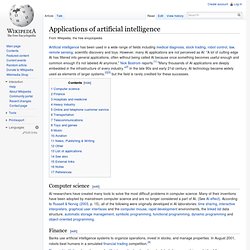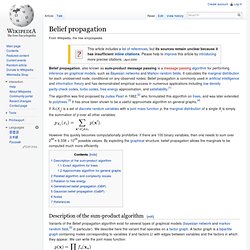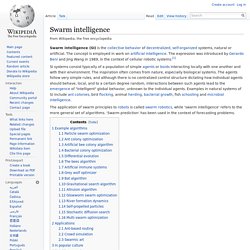

Artificial Intelligence: A Modern Approach. Evolvable hardware. Evolvable hardware (EH) is a new field about the use of evolutionary algorithms (EA) to create specialized electronics without manual engineering. It brings together reconfigurable hardware, artificial intelligence, fault tolerance and autonomous systems. Evolvable hardware refers to hardware that can change its architecture and behavior dynamically and autonomously by interacting with its environment. Introduction[edit] Each candidate circuit can either be simulated or physically implemented in a reconfigurable device. Typical reconfigurable devices are field-programmable gate arrays (for digital designs) or field-programmable analog arrays (for analog designs). The concept was pioneered by Adrian Thompson at the University of Sussex, England, who in 1996 evolved a tone discriminator using fewer than 40 programmable logic gates and no clock signal in a FPGA.
Why evolve circuits? In many cases, conventional design methods (formulas, etc.) can be used to design a circuit. Exploring the the Darkside of Artificial Intelligence, thoughts, ideas, rants, and research. Noam Chomsky on Where Artificial Intelligence Went Wrong - Yarden Katz. An extended conversation with the legendary linguist Graham Gordon Ramsay If one were to rank a list of civilization's greatest and most elusive intellectual challenges, the problem of "decoding" ourselves -- understanding the inner workings of our minds and our brains, and how the architecture of these elements is encoded in our genome -- would surely be at the top.

Yet the diverse fields that took on this challenge, from philosophy and psychology to computer science and neuroscience, have been fraught with disagreement about the right approach. In 1956, the computer scientist John McCarthy coined the term "Artificial Intelligence" (AI) to describe the study of intelligence by implementing its essential features on a computer. Instantiating an intelligent system using man-made hardware, rather than our own "biological hardware" of cells and tissues, would show ultimate understanding, and have obvious practical applications in the creation of intelligent devices or even robots. Yarden Katz. Applications of artificial intelligence. Artificial intelligence has been used in a wide range of fields including medical diagnosis, stock trading, robot control, law, remote sensing, scientific discovery and toys.

However, many AI applications are not perceived as AI: "A lot of cutting edge AI has filtered into general applications, often without being called AI because once something becomes useful enough and common enough it's not labeled AI anymore," Nick Bostrom reports.[1] "Many thousands of AI applications are deeply embedded in the infrastructure of every industry.
" In the late 90s and early 21st century, AI technology became widely used as elements of larger systems, but the field is rarely credited for these successes. Computer science[edit] AI researchers have created many tools to solve the most difficult problems in computer science. Artificial consciousness. Artificial consciousness (AC), also known as machine consciousness (MC) or synthetic consciousness (Gamez 2008; Reggia 2013), is a field related to artificial intelligence and cognitive robotics whose aim is to "define that which would have to be synthesized were consciousness to be found in an engineered artifact" (Aleksander 1995).

Neuroscience hypothesizes that consciousness is generated by the interoperation of various parts of the brain, called the neural correlates of consciousness or NCC. Proponents of AC believe it is possible to construct machines (e.g., computer systems) that can emulate this NCC interoperation.
Predicate Logic. Propositional Logic. Gerbrandy.nfshost.com/science/papers/distributed_knowledge.pdf. Belief propagation. Belief propagation, also known as sum-product message passing is a message passing algorithm for performing inference on graphical models, such as Bayesian networks and Markov random fields.

It calculates the marginal distribution for each unobserved node, conditional on any observed nodes. Www.aifb.kit.edu/images/1/19/DL-Intro.pdf.
Artificial intelligence. AI research is highly technical and specialized, and is deeply divided into subfields that often fail to communicate with each other.[5] Some of the division is due to social and cultural factors: subfields have grown up around particular institutions and the work of individual researchers.

AI research is also divided by several technical issues. Some subfields focus on the solution of specific problems. Others focus on one of several possible approaches or on the use of a particular tool or towards the accomplishment of particular applications. The central problems (or goals) of AI research include reasoning, knowledge, planning, learning, natural language processing (communication), perception and the ability to move and manipulate objects.[6] General intelligence is still among the field's long-term goals.[7] Currently popular approaches include statistical methods, computational intelligence and traditional symbolic AI. History[edit] Swarm intelligence. Swarm intelligence (SI) is the collective behavior of decentralized, self-organized systems, natural or artificial.

The concept is employed in work on artificial intelligence. The expression was introduced by Gerardo Beni and Jing Wang in 1989, in the context of cellular robotic systems.[1] The application of swarm principles to robots is called swarm robotics, while 'swarm intelligence' refers to the more general set of algorithms. 'Swarm prediction' has been used in the context of forecasting problems. AI Repositories and Resource Lists.